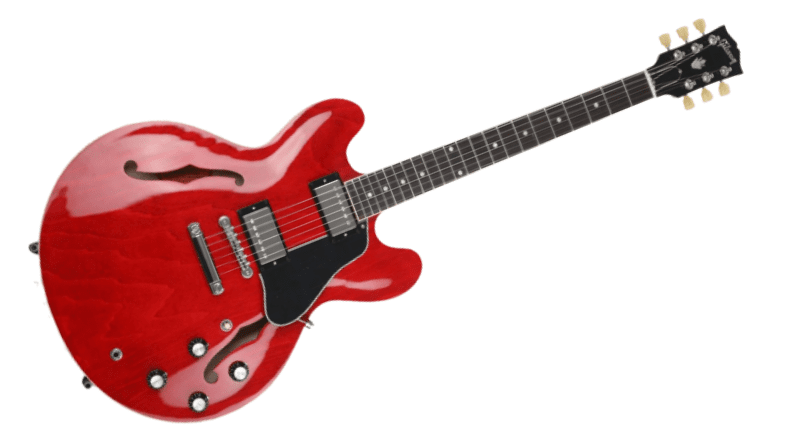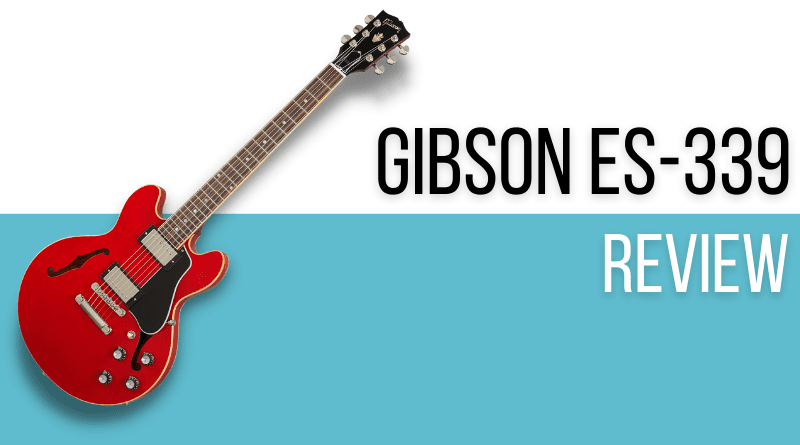The Gibson ES-335 has been a mainstay of the Gibson lineup since its release in 1958, but its large size isn’t particularly forgiving to the majority of players, especially smaller guitarists – enter the Gibson ES-339.
In 2007 Gibson released their much anticipated ES-339, it was like the 335 in almost every way, but with reduced proportions, making it much more ergonomic, while retaining the style and tones of the full size model
In this KillerGuitarRigs Review, we got the opportunity to spend some time with the Gibson ES-339. The 335 has been a favorite at KGR for a long time, so we were extremely keen to see how the smaller guitar stacked up. Keep on reading to see what we learned.
Read more about our review process.
Contents
Who Is The Gibson ES-339 For?
The Gibson ES-339 is really aimed at intermediate and above players. Of course, it offers excellent playability thanks to its more compact size, but the price tag is prohibitive for the majority of newer guitarists.
We’d highly recommend the ES-339 for players who love the style and tones of Gibson’s big semi hollow bodies, but who perhaps found them to be too bulky to play comfortably.
Appearance / Features / Controls
Our test model was finished in the classic “Cherry” color, as made famous by Marty McFly in Back to the Future. The finish was masterfully applied, and the nitro lacquer looked great and felt fantastic to the touch. With the nitro it will age beautifully with time and use, too.
As mentioned already, the ES-339 does have a semi hollow body. The outer body is made from a 3 ply maple and poplar combination, while the center block is made from solid maple. The neck was a set, rounded C profile, and was made from mahogany.
Topping off the body was a lovely aged white, almost cream binding. It was on both sides of the body, as well as the neck, and being a Gibson, the fret ends were nibbed underneath the binding. The F holes weren’t bound, but the paint and clearcoat finish on their edges was very nicely applied, so binding wasn’t too badly missed here.
It was fitted with typical Gibson hardware. It was all top quality, with a Tune-o-Matic bridge and stop bar tailpiece, as well as chromed Grover tuners. We loved that it came stock from the factory with a Graphtech NuBone nut, too.
Given that this is a vintage style guitar, the choice of pickups made complete sense. It was fitted with a pair of ’57 Classic humbucking pickups. For those familiar with the famous PAF, or Patent Applied For humbuckers fitted to vintage Gibsons, these pups are a recreation of those legendary units.
We also loved that it came complete with a hard side, Gibson branded case, too.
Performance/Sound
Fans of lightweight guitars will absolutely love the ES-339. At just 6lb 15oz, it was incredibly comfortable to hold for extended periods. If you’re used to Les Pauls, this might come as quite a shock.
We found the playability to be absolutely fantastic. The rounded C profile neck was slick and extremely comfortable, and because the binding covered the fret edges entirely, the comfort factor was even further increased.
The frets were some of the best we’ve found on any guitar we’ve reviewed. They actually come PLEK’d from the factory, so as expected, they were perfectly level, and glassy smooth.
It came with a rosewood fretboard, which arrived to us in perfect condition. It wasn’t dry, and the pores weren’t excessively open. The grain looked incredible, and it was plain to see care had gone into the manufacture of this guitar.
The resonance and sustain we got from the ES-339 were superb. To our ears, there was no discernible difference in these elements between this guitar and the ES-335, so there’s no real sacrifice in going to the smaller body – if it’s what you find more comfortable, then it’s a win-win.
Tonally it was superb. The ’57 Classic pickups excelled with blues and rock as you might imagine, putting out a throaty growl when introduced to some overdrive in the signal chain. They also performed nicely with clean styles too, for example, our Jazz chords were crisp and clear, while still remaining warm and ear pleasing.
Other Guitars to Consider
The Gibson ES-339 is a real powerhouse of a guitar. It handles a huge range of genres, and looks incredible while doing so. Despite having so much going for it, you might end up finding that it’s not for you. If you’d like to take a look at some alternatives, we’ve highlighted a couple of our favorites below.
Gibson ES-335

The Gibson ES-335 is the most obvious alternative to the ES-339. It’s practically the same guitar, but it comes with the original, full size body. If you’re more comfortable with a larger guitar, and you still want those classic Gibson looks and tones, the ES-335 might be a good choice for you (or the Epiphone model if you’re on a budget).
Gretsch G6669TG Player’s Edition Broadkaster Jr. Center Block

The Gretsch G6669TG Player’s Edition Broadkaster Jr. Center Block is a much more ornate semi hollow guitar than the Gibson ES-339, and will suit those who are looking for a little more flare perfectly. The Full’Tron humbucking pickups are super hot, and provide huge tones and unbelievable grunt when pushed hard, while the chambered spruce center block provides tons of punch and incredible sustain.
Final Thoughts in our Gibson ES-339 Review
The Gibson ES-339 might be a modern model in terms of release date, but it’s otherwise all vintage. Players who always loved the idea of playing a semi hollow Gibson, but hesitated due to the bulk of the ES-335 now have a genuine option.
It’s a guitar that may cost quite a lot at the point of purchase, but ES model Gibsons tend to hold their value extremely well, and as an added bonus, as they break in with age, they play even better. The ES-339 can be hard to come by, so if you’re on the fence and you happen to find one for sale, we highly recommend you take the plunge.


